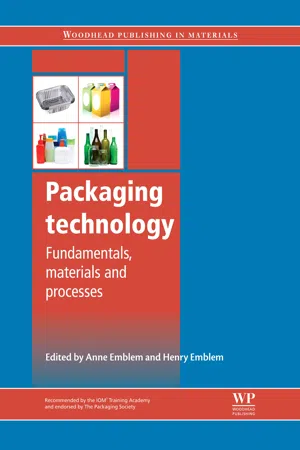
- 600 pages
- English
- ePUB (mobile friendly)
- Available on iOS & Android
About this book
Packaging is a complex and wide-ranging subject. Comprehensive in scope and authoritative in its coverage, Packaging technology provides the ideal introduction and reference for both students and experienced packaging professionals.Part one provides a context for the book, discussing fundamental issues relating to packaging such as its role in society and its diverse functions, the packaging supply chain and legislative, environmental and marketing issues. Part two reviews the principal packaging materials such as glass, metal, plastics, paper and paper board. It also discusses closures, adhesives and labels. The final part of the book discusses packaging processes, from design and printing to packaging machinery and line operations, as well as hazard and risk management in packaging.With its distinguished editors and expert contributors, Packaging technology is a standard text for the packaging industry. The book is designed both to meet the needs of those studying for the Diploma in Packaging Technology and to act as a comprehensive reference for packaging professionals.- Provides the ideal introduction and reference for both students and experienced packaging professionals- Examines fundamental issues relating to packaging, such as its role in society, its diverse functions, the packaging supply chain and legislative, environmental and marketing issues- Reviews the principal packaging materials such as glass, metal, plastics, paper and paper board
Frequently asked questions
- Essential is ideal for learners and professionals who enjoy exploring a wide range of subjects. Access the Essential Library with 800,000+ trusted titles and best-sellers across business, personal growth, and the humanities. Includes unlimited reading time and Standard Read Aloud voice.
- Complete: Perfect for advanced learners and researchers needing full, unrestricted access. Unlock 1.4M+ books across hundreds of subjects, including academic and specialized titles. The Complete Plan also includes advanced features like Premium Read Aloud and Research Assistant.
Please note we cannot support devices running on iOS 13 and Android 7 or earlier. Learn more about using the app.
Information
Packaging and society
Abstract:
1.1 Introduction: packaging from a historical perspective
1.2 Social developments: the changing patterns of consumption and their impact on packaging
1.2.1 The Industrial Revolution
1.2.2 Modern packaging
1.2.3 Lifestyle changes and their impact on packaging
1.3 ...
Table of contents
- Cover image
- Title page
- Table of Contents
- Copyright
- Contributor contact details
- Note about the editors
- Preface
- Part I: Packaging fundamentals
- Part II: Packaging materials and components
- Part III: Packaging processes
- Index